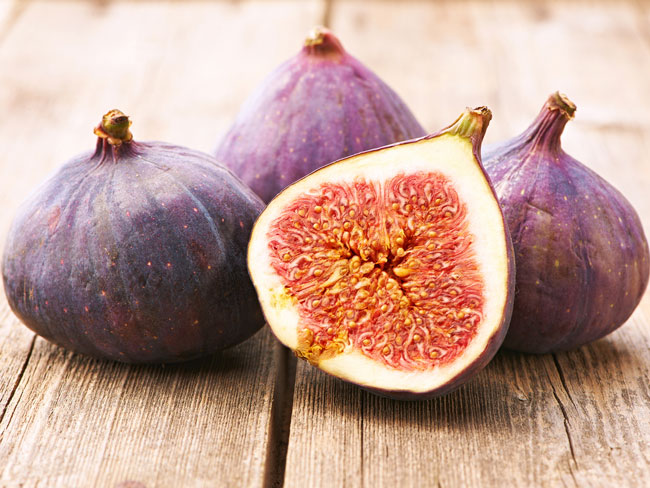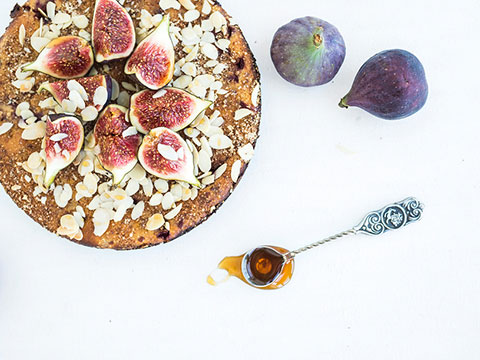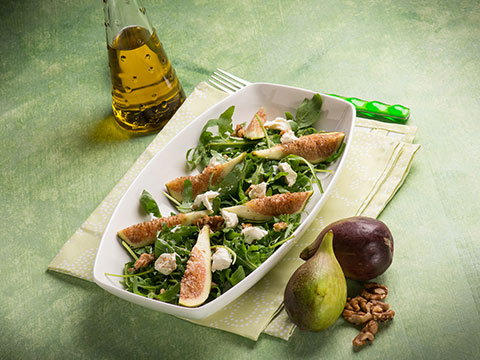Fabulous Figs
- By Stephanie Rosenbaum Klassen
- Reading Time: 4 mins.
 On the West Coast, summer tends to linger. Back-to-school sales may cede shelf space to Halloween candy, but even as the days grow shorter, golden afternoons beckon, encouraging weekend picnics and last-chance outdoor dinners.
On the West Coast, summer tends to linger. Back-to-school sales may cede shelf space to Halloween candy, but even as the days grow shorter, golden afternoons beckon, encouraging weekend picnics and last-chance outdoor dinners.
Now is the time to make the most of the autumn fig crop, currently in succulent full swing. Fig trees flourish in California’s dry, temperate Mediterranean climate, typically producing two full crops a year. Figs first came to California in the mid-18th century, brought by Spanish and Portuguese missionaries. From Santa Barbara to Sonoma, the indigo-skinned, ruby-fruited cultivar they planted became known as the Mission fig. To this day, Mission figs remain one of California’s most popular and widely grown figs. But fig lovers also seek other, less common varieties, including the Calimyrna, the Adriatic, the Brown Turkey, and the Kadota.
The fig, like the olive, is rooted deeply in human civilization. Well suited to heat and drought, the trees (Ficus carica) have been cultivated for at least 5,000 years, beginning in ancient Mesopotamia (modern-day Iraq and Syria) and quickly spreading east to the Arabian deserts and west to the Mediterranean basin and southern Europe. Both the Bible and the Koran extol the virtues of the fig, while the Roman author Pliny the Elder included “one hundred and eleven observations” on the fig in his Natural History, written between 77–79 CE.
Want farm-fresh fruit?
We've got you covered.Fresh and Fleeting
When perfectly ripe, fresh figs are both fragile and highly perishable, which explains why 95 percent of California’s fig crop is processed into sturdier, more long-lasting dried fruit or jams.
A ripe fig should feel plump and soft and yield to the touch. Skin color is not an indicator of ripeness; depending on the variety, the skin may be purple, brown, light green, or even yellow-and-green striped.
How to ripen unripe figs: Place hard figs stem-up on a plate in a warm room. Leave room for air around each fig; they may mold if crowded together. Check frequently and eat when very soft. A fully ripe fig may show tiny cracks in the skin, along with a drop or two of honey-like juice oozing out the small hole at the bottom of the fruit. Once ripe, they’ll last in the refrigerator for a couple of days. For best flavor, let them come back to room temperature before eating.
How to eat figs: Figs make a perfect pairing with tangy cheeses such as chèvre (fresh goat cheese), feta, or blue cheese. Figs are delicious wrapped in sheer, salty slices of prosciutto, or wrapped in bacon and quickly grilled or broiled. They are a perfect topping to a green salad of mixed baby lettuces or arugula, dressed with olive oil, balsamic vinegar, and a sprinkle of fresh thyme. Overripe figs can be baked into buttery, almond-scented cakes, or gently simmered into compotes with wine or fruit juice, sweet spices, and honey. They may be best enjoyed on their own, though, simply sliced when perfectly ripe—a final, concentrated taste of summer’s sweetness.
FIG-THEMED RECIPES:
 Fig and Almond Cake
Fig and Almond Cake
INGREDIENTS
- 1 cup whole almonds, lightly toasted
- ⅓ cup sugar
- ¼ cup all-purpose flour
- ½ teaspoons baking powder
- ½ teaspoon cardamom
- ¼ teaspoons salt
- 4 tablespoons butter
- 3 eggs, beaten
- 2 tablespoons honey
- ½ teaspoons almond extract
- 14 figs, cut in half lengthwise
- 2 tablespoons sugar mixed with ¼ teaspoon cinnamon, for sprinkling
- 2 tablespoons sliced almonds for sprinkling (optional).
PREPARATION
- Preheat oven to 375ºF. Grease a 9-inch round cake pan. Using a blender or food processor, grind almonds and ⅓ cup sugar together into a coarse powder. Set aside.
- In a medium saucepan over medium heat, melt butter. Continue to cook until it turns amber and smells toasty. Remove from heat and let cool for a few minutes.
- In a large bowl, whisk together almond and sugar mixture, flour, baking powder, cardamom, and salt. In a separate bowl, whisk together the browned butter, eggs, honey, and almond extract. Pour butter mixture into flour and stir, quickly and gently, until just mixed.
- Pour batter into prepared pan. Arrange figs, cut side up, on top of the batter. Sprinkle with cinnamon sugar. Bake for 30 minutes, until top is golden brown and a tester comes out clean. Remove from oven and let cool on a rack. Sprinkle with cinnamon sugar (and optional sliced almonds).
Serves 8–10. Prep time: 30 minutes. Cook time: 30 minutes.
Want farm-fresh fruit?
We've got you covered. Fig and Arugula Salad with Pancetta and Goat Cheese
Fig and Arugula Salad with Pancetta and Goat Cheese
INGREDIENTS
Fig-Port Vinaigrette:
- 3 figs, roughly chopped
- 1 cup ruby port
- ¼ cup red wine vinegar
- ½ tablespoon minced shallots
- ¼ cup mild olive oil or grapeseed oil
- Salt and freshly ground pepper to taste
Salad:
- ½ pound pancetta (Italian unsmoked bacon) or bacon, diced
- 6 figs, cut in quarters or eighths lengthwise
- 3 bunches arugula
- 1 cup pecans, lightly toasted (optional)
- 1 cup crumbled goat cheese
PREPARATION
- To make the vinaigrette, soak the figs in port for 30 minutes. In a small saucepan, simmer figs and port together until the port has reduced by half. In a blender, purée figs, port, and vinegar together until smooth. Whisk in shallots and oil. Season with salt and pepper to taste.
- In a sauté pan over medium heat, cook pancetta or bacon until crisp. Drain and set aside. In a large bowl, toss arugula and figs with half the vinaigrette. Arrange on salad plates. Top with pancetta, pecans if using, and cheese. Drizzle with additional vinaigrette as needed.
Serves 6. Prep time: 30 minutes. Cook time: 30 minutes.
Want farm-fresh fruit?
We've got you covered.
Stephanie Rosenbaum Klassen is the author of six books, including Honey: From Flower to Table (Chronicle Books) and Fun Food: Kids in the Kitchen (Williams-Sonoma). She writes frequently about seasonal cooking and holds a certificate in ecological horticulture from the Center for Agroecology and Sustainable Food Systems at UC Santa Cruz.


